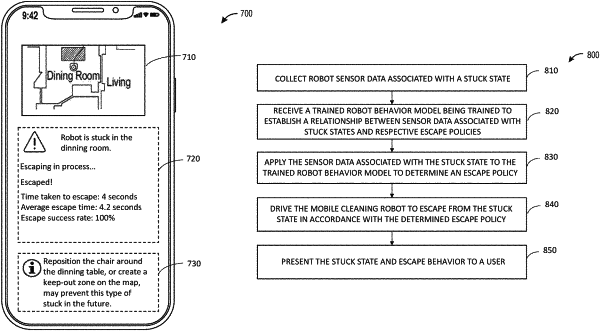| CPC G05D 1/0221 (2013.01) [A47L 9/009 (2013.01); A47L 9/2826 (2013.01); A47L 9/2852 (2013.01); A47L 9/2894 (2013.01); G05D 1/027 (2013.01); G05D 1/0242 (2013.01); G05D 1/0246 (2013.01); G05D 1/0272 (2013.01); A47L 2201/04 (2013.01); G05D 2201/0215 (2013.01)] | 36 Claims |

|
1. A system comprising:
a mobile cleaning robot, comprising:
a drive system including at least one electric motor configured to move the mobile cleaning robot about an environment;
a sensor circuit configured to collect sensor data associated with a stuck state preventing the mobile cleaning robot from driving in the environment;
a training module configured to select, from a set of mobile cleaning robots, a cohort fewer than the set of mobile cleaning robots and satisfying a robot grouping criterion, and to generate a trained robot escape behavior model using sensor data collected from the selected cohort of mobile cleaning robots, the trained robot escape behavior model being trained to establish a relationship between (1) training sensor data associated with one or more stuck states and (2) respective escape policies each including an instruction to the drive system or an actuator of the mobile cleaning robot to get the mobile cleaning robot away from a corresponding stuck state; and
a controller circuit configured to:
detect a stuck event that has occurred and prevented the mobile cleaning robot from driving in the environment;
use the detected stuck event to trigger a determination of an escape policy by applying the collected sensor data associated with the stuck state to the trained robot escape behavior model; and
generate a control signal to the drive system or the actuator to escape from the stuck state in accordance with the determined escape policy.
|